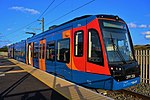Parkgate F.C.
1969 establishments in EnglandAssociation football clubs established in 1969Football clubs in EnglandFootball clubs in South YorkshireHatchard League ... and 7 more
Northern Counties East Football LeagueSheffield & Hallamshire County FA membersSheffield Association LeagueSport in RotherhamUse British English from June 2018Works association football teams in EnglandYorkshire Football League
Parkgate Football Club is an English football club based in Parkgate, Rotherham, South Yorkshire. They play in the Northern Counties East Football League Division One, at level 10 of the English football league system.
Excerpt from the Wikipedia article Parkgate F.C. (License: CC BY-SA 3.0, Authors).Parkgate F.C.
Boundary Green,
Geographical coordinates (GPS) Address Nearby Places Show on map
Geographical coordinates (GPS)
| Latitude | Longitude |
|---|---|
| N 53.458127777778 ° | E -1.3345416666667 ° |
Address
Boundary Green
S62 6JY , Parkgate
England, United Kingdom
Open on Google Maps






